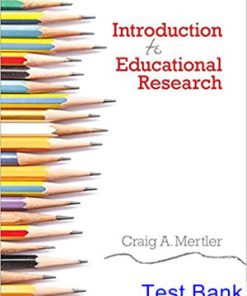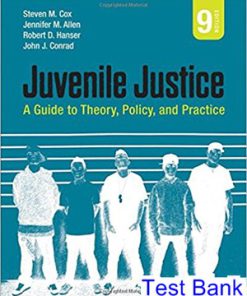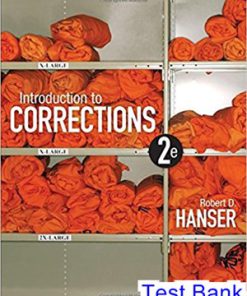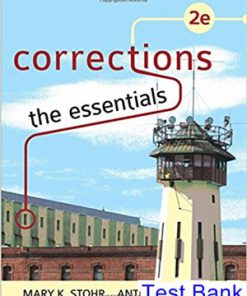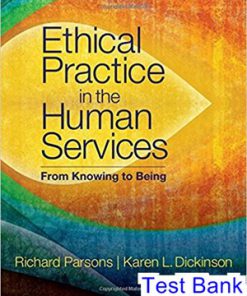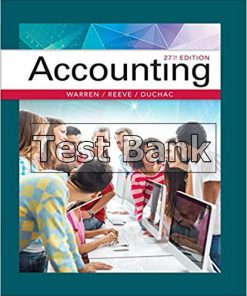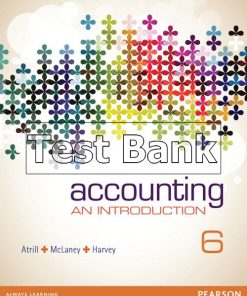Corrections From Research to Policy to Practice 1st Edition Stohr Test Bank
$50.00 Original price was: $50.00.$26.50Current price is: $26.50.
Corrections From Research to Policy to Practice 1st Edition Stohr Test Bank.
Corrections From Research to Policy to Practice 1st Edition Stohr Test Bank
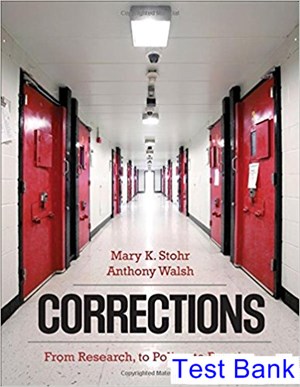
Product details:
- ISBN-10 : 1483373371
- ISBN-13 : 978-1483373379
- Author: Mary K. Stohr
Corrections: From Research, to Policy, to Practice offers students a 21st-century look into the treatment and rehabilitative themes that drive modern-day corrections. Written by two academic scholars and former practitioners, Mary K. Stohr and Anthony Walsh, this book provides students with a comprehensive and practical understanding of corrections, as well as coverage of often-overlooked topics like ethics, comparative corrections, offender classification and assessment, treatment modalities, and specialty courts. This text expertly weaves together research, policy, and practice, enabling students to walk away with a foundational understanding of effective punishment and treatment strategies for offenders in U.S. correctional institutions.
Table contents:
- Part I • Foundations of Corrections
- Chapter 1 • The Philosophical and Ideological Underpinnings of Corrections
- What Is Punishment?
- Introduction: What Is Corrections?
- From Arrest to Punishment
- The Theoretical Underpinnings of Corrections
- The Foundation of Correctional Punishment
- Perspective From a Practitioner: Robert Bayer, Former Director of Corrections and Prison Warden; Currently an Adjunct Professor and Prison Consultant
- The Emergence of the Classical School
- The Emergence of Positivism: Should Punishment Fit the Offender or the Offense?
- The Function of Punishment
- The Philosophical Assumptions Behind Justifications for Punishment
- The Major Punishment Justifications
- Retribution
- Deterrence
- Incapacitation
- Selective Incapacitation
- Rehabilitation
- Policy and Research: Economists Look at Incapacitation
- Ethical Issue 1.1: What Would You Do?
- Reintegration
- The Due Process and Crime Control Models
- The Crime Control Model
- The Due Process Model
- Choosing a Model
- Summary
- Key Terms
- Discussion Questions
- Useful Internet Sites
- Chapter 2 • Early Corrections: From Ancient Times to Colonial Jails and Prisons
- Narrative of Three Men Placed in the Missouri State Prison For Helping Slaves Escape via the Underground Railroad (1847)
- Introduction: The Evolving Practice of Corrections
- Themes: Truths That Underlie Correctional Practice
- Early Punishments in Westernized Countries
- The First Jails
- Galley Slavery
- Poverty and Bridewells, Debtors’ Prisons, and Houses of Correction
- In Focus 2.1: The Tower of London
- Transportation
- Ethical Issue 2.1: What Would you Do?
- Enlightenment—Paradigm Shift
- Spock Falls in Love
- Ethical Issue 2.2 What Would you Do?
- John Howard
- Bentham and Beccaria
- In Focus 2.2: Modern-Day John Howard—Dr. Ken Kerle
- William Penn
- Colonial Jails and Prisons
- Comparative Perspective
- Early European and British Prisons
- Perspective From a Practitioner: Marianne Fisher-Giorlando, Board Member of Louisiana State Penitentiary Museum Foundation, Chair of the Education Committee, and Member of The Accession/Deaccession Committee
- Summary
- Key Terms
- Discussion Questions
- Useful Internet Sites
- Chapter 3 • Correctional History: Early Prisons to Corrections Today
- Jim Crow Treatment in Prisons
- Introduction: The Grand Reforms
- Early Modern Prisons
- The Walnut Street Jail
- Newgate Prison, New York City
- Emerging Prison Models
- The Pennsylvania Prison Model (Separate System)
- Auburn, Sing Sing, and the New York (Congregate) System
- Ethical Issue 3.1: What Would You Do?
- In Focus 3.1: Charles Dickens’s Impressions of Eastern State Penitentiary and the Silent System in 1842
- In Focus 3.2: The Pentonville Prison
- Early Prisons and Jails Not Reformed
- Prisons: “The Shame of Another Generation”
- Dorothea Dix’s Evaluation of Prisons and Jails
- In Focus 3.3: Lewis E. Lawes’s Observations About Sing Sing History and Discipline
- The Failure of Reform Is Noted
- Ethical Issue 3.2: What Would You Do?
- The Renewed Promise of Reform
- The 1870 American Prison Congress
- Elmira
- The Creation of Probation and Parole
- American Corrections in the 20th and 21st Centuries
- Southern and Northern Prisons and the Contract and Lease Systems
- Correctional Institutions or Warehouse Prisons?
- Themes That Prevail in Correctional History
- Perspective From a Practitioner: Pat Mahoney, Alcatraz Corrections Officer and Boat Captain
- Summary
- Key Terms
- Discussion Questions
- Useful Internet Sites
- Chapter 4 • Ethics and Corrections
- A Novice Bows to Subcultural Pressure
- Introduction: To Do the Right Thing!
- Defining Ethics: What Is Right (and Wrong)?
- In Focus 4.1: A Lack of Ethics: Florida’s Youth Services International Private Prisons for Youth
- Ethical Foundation for Professional Practice
- Ethical Formalism
- Policy and Research: Mentally Ill Inmate Dies at Rikers
- Utilitarianism
- Religious Perspective
- Natural Law
- Ethics of Virtue
- Ethics of Care
- Egoism
- Why People Behave Unethically
- Official Deviance
- Ethical Issue 4.1: What Would You Do?
- Noble Cause Corruption
- In Focus 4.2: Subcultural Values of Probation and Parole Officers
- Subculture
- How to Prevent Unethical Behavior and Promote Ethical Work Practices
- In Focus 4.3: The Abuse of Solitary Confinement in Florida
- War on Drugs = Attack on Ethics?
- Ethical Issue 4.2: What Would You Do?
- Summary
- Key Terms
- Discussion Questions
- Useful Internet Sites
- Part II • The Correctional System
- Chapter 5 • Sentencing: The Application of Punishment
- Vindictive Versus Sensible Sentencing
- Introduction: What Is Sentencing?
- Types of Sentences
- Indeterminate Sentence
- Determinate Sentence
- Mandatory Sentence
- Concurrent and Consecutive Sentences
- Habitual Offender Statutes
- Alternatives to Incarceration
- Plea Bargaining
- Ethical Issue 5.1: What Would You Do?
- In Focus 5.1: Sentencing by Civil Commitment for Sex Offenders
- Benefits of Plea Bargains
- Criticisms of Plea Bargains
- In Focus 5.2: Extension of the Due Process Model to Sentencing
- Impact Statements at Sentencing
- Victim Impact Statements
- Sentencing Disparities: Legitimate and Illegitimate
- Policy and Research: Sentencing for Crack Versus Powder Cocaine
- Structuring Judicial Sentencing Choices
- The Presentence Investigation Report
- In Focus 5.3: Example of a Presentence Investigation Report
- Ethical Issue 5.2: What Would You Do?
- Sentencing Guidelines
- Perspective From a Practitioner: Laura Kiehl, Presentence Investigator
- The Future of Sentencing Guidelines
- In Focus 5.4: Policy Statement of the American Correctional Association Regarding Sentencing
- Summary
- Key Terms
- Discussion Questions
- Useful Internet Sites
- Chapter 6 • Jails and Detention Centers
- A Mentally Ill Inmate in the Dona Ana County Jail, New Mexico
- Introduction: The Community Institution
- Jail Types
- Jail Inmates and Their Processing
- Trends in Jail Populations
- Overcrowding
- Perspective From a Practitioner: Brian Cole, County Corrections Director
- Race, Ethnicity, Gender, and Juveniles
- Policy and Research: High Schools in Jails
- The Poor and the Mentally Ill
- In Focus 6.1: An Account of Suicide, Mental Health, and the Need for Increased Mental Health Services
- Medical Problems
- Elderly Inmates
- Female Inmates
- Juvenile Inmates
- Rights to Medical Care
- Substance Abuse and Jails
- Suicides, Gangs, and Sexual Violence in Jails
- Suicides
- Gangs
- Sexual Violence
- Ethical Issue 6.1: What Would You Do?
- Innovations in Jails
- New-Generation, or Podular Direct Supervision Jails
- In Focus 6.2: Prison Rape Elimination Act Controversy
- Community Jails
- Ethical Issue 6.2: What Would You Do?
- Coequal Staffing
- Reentry Programs for Jails
- Release on Recognizance and Bail Programs for Jails
- Summary
- Key Terms
- Discussion Questions
- Useful Internet Sites
- Chapter 7 • Special Problem-Solving Courts in Corrections
- Veterans Courts in Action
- Introduction: What Are Problem-Solving Courts?
- Drug Courts
- The Drug Court Process
- Some Pros and Cons of Drug Courts
- Ethical Issue 7.1: What Would You Do?
- Policy and Research: Evaluating Drug Court Performance
- New Jersey Drug Court Program: Testimonials
- Ethical Issue 7.2: What Would You Do?
- Mental Health Courts
- The Mental Health Court Process
- Some Pros and Cons of Mental Health Courts
- Veterans Courts
- The Veterans Court Process
- Some Pros and Cons of Veterans Courts
- Domestic Violence Courts
- The Domestic Violence Court Process
- Perspective From a Practitioner: Honorable Judge Robert Russell, Judge of Buffalo Treatment Courts and Acting Judge of Erie County Court
- Community Courts
- The Community Court Process
- Summary
- Key Terms
- Discussion Questions
- Useful Internet Sites
- Chapter 8 • Community Corrections: Probation and Intermediary Sanctions
- Betty’s Reproductive Rights Versus the Protection of Children and Society
- Introduction: The Origins of Probation
- Founding Fathers of Probation: John Augustus and Matthew Davenport Hill
- Probation Today
- Why Do We Need Community Corrections?
- The Probation Officer Role
- Models of Probation Supervision
- Ethical Issue 8.1: What Would You Do?
- Ethical Issue 8.2: What Would You Do?
- Probation Officer Stress
- Perspective From a Practitioner: Brian Fallock, Probation and Parole Agent
- Policy and Research: The EPICS Model of Probation Supervision
- Strategies to Reduce Recidivism
- Probation Violations and Graduated Sanctions
- Engaging the Community to Prevent Recidivism
- In Focus 8.1: Becoming a Volunteer Probation Officer in Orange County
- In Focus 8.2: Community Supervision and Recidivism
- Intermediate Sanctions
- Work Release
- Intensive Supervision Probation
- Shock Probation or Parole and Boot Camps
- Victim–Offender Reconciliation Programs
- Summary
- Key Terms
- Discussion Questions
- Useful Internet Sites
- Chapter 9 • Prisons and the Correctional Client
- Kitchen Supervisor Sexually Abuses Two Male Inmates
- Introduction: The State of Prisons
- Prison Organizations
- Classification
- Prison Types and Levels
- Prison Value?
- Attributes of the Prison That Shape the Experience
- Total Institutions, Mortification, Importation, Prisonization
- Pains of Imprisonment
- The Prison Subculture
- Gangs and the Prison Subculture
- Violence
- Why Prisons Are Violent
- The Amount of Violence
- Sexual Assaults
- In Focus 9.1: Alabama Prisons Violate the Constitution
- Rioting
- Solutions: Strategies to Reduce Violence, Mature Coping, and Social Support
- Strategies to Reduce Violence
- Mature Coping
- Perspective from a Practitioner: Michael Klein, Correctional Officer
- Social Support
- Special Populations
- The Elderly and the Physically and Mentally Ill
- Lesbian, Gay, Bisexual, Transgender, and Intersex Inmates
- Summary
- Key Terms
- Discussion Questions
- Useful Internet Sites
- Chapter 10 • Classification and Assessment of Offenders
- The Challenges of Classification
- Introduction: What Is Classification and Assessment?
- Predicting Behavior
- Assessing Risks and Needs
- The History of Classification and Assessment
- Early Attempts at Classification
- Classification Today
- Ethical Issue 10.1: What Would You Do?
- The National Institute of Corrections Custody Classification Model
- Perspective From a Practitioner: Sheila Gibson, Assessment and Classification Specialist
- Adult Internal Management System
- Policy and Research: Assessment and Classification of Sex Offenders
- Ethical Issue 10.2: What Would You Do?
- Needs Assessment and Classification
- Psychopathy Checklist–Revised
- Assessment and Classification in Community Corrections
- The Client Management Classification Assessment Instrument
- Risk and Needs Assessment Scales
- The Case Management Classification and Supervision Levels
- Selective Intervention
- Environmental Structure
- Casework and Control
- Limit Setting
- Summary
- Key Terms
- Discussion Questions
- Useful Internet Sites
- Chapter 11 • Correctional Programming and Treatment
- Life’s Turning Points
- Introduction: The Rise and Fall (and Rise Again) of Rehabilitation
- In Focus 11.1: The American Correctional Association 1870 Declaration on Treatment
- The Shift From “Nothing Works” to “What Works?”
- Ethical Issue 11.1: What Would You Do?
- Evidence-Based Practices
- Motivational Interviewing
- Cognitive Behavioral Therapy
- Cognitive Behavioral Therapy and Criminal Thought
- Substance Abuse Programming
- Policy and Research: Can Psychopaths Be Treated?
- Drug Treatment With Swift Consequences for Failure: HOPE Program
- Therapeutic Communities
- Perspective From a Practitioner: Margaret Jackson, Drug Treatment Specialist
- Ethical Issue 11.2: What Would You Do?
- Pharmacological Treatment
- Anger Management
- Sex Offenders and Their Treatment
- Pharmacological Treatment
- Mentally Ill Offenders
- Educational and Vocational Programs
- Summary
- Key Terms
- Discussion Questions
- Useful Internet Sites
- Chapter 12 • Parole and Prisoner Reentry
- The Perils of Parole
- Introduction: What Is Parole?
- A Brief History of Parole
- The Modern Parole System
- In Focus 12.1: Example of Parole Conditions
- Parolee Recidivism
- Parole Boards
- Perspective From a Practitioner: Lisa Growette Bostaph, Parole Commissioner
- Ethical Issue 12.1: What Would You Do?
- What Goes In Must Come Out: Prisoner Reentry Into the Community
- The Impact of Imprisonment and Reentry on Communities
- The Process of Reentry
- The Role of Employment for Successful Reentry
- Policy and Research: Offenders’ Attitudes Toward Parole
- Determining Parole Success
- Parole Violations
- Approaches to Parole
- Halfway Houses
- House Arrest
- Electronic Monitoring and Global Positioning Systems
- Ethical Issue 12.2: What Would You Do?
- Concluding Remarks on Reentry and Recidivism
- Summary
- Key Terms
- Discussion Questions
- Useful Internet Sites
- Part III • Correctional Administration
- Chapter 13 • Correctional Organizations and Their Management
- Responses to Realignment
- Introduction: Correctional Organizations and Their Management
- Organizational-Level Factors That Affect Correctional Operations
- Bureaucracies
- Closed and Open Institutions
- Total Institutions
- Formal and Informal Organizations
- Management Theories
- Traditional Theories of Management
- Human Relations Theories of Management
- Combining Traditional and Human Relations Theories
- Elements of Effective Organizations
- Communication
- Perspective From a Practitioner: Teri Herold-Prayer, Veteran Services Manager
- Leadership and Why It Matters
- Organizational Culture
- Ethical Issue 13.1: What Would You Do?
- Policy and Research: Management of Correctional Organizations
- Summary
- Key Terms
- Discussion Questions
- Useful Internet Sites
- Chapter 14 • The Corrections Experience for Staff
- John’s Tragic Story
- Introduction: What Is a Profession?
- The State of the Work in Correctional Institutions and Programs
- Growth in Staff and Clients or Inmates
- Perceived Benefits of Correctional Work
- Collective Bargaining
- Why Require More Education and Training?
- Stanford Prison Experiment
- Abu Ghraib
- Ethics
- In Focus 14.1: ACA Code of Ethics
- Correctional Work Is Little Understood
- Individual-Level Factors That Affect the Correctional Workplace
- Race or Ethnicity and Gender
- Perspective From a Practitioner: Michael Klein, Correctional Officer
- Age
- Prior Military Service
- Correctional Roles
- The Role Defined
- Street-Level Bureaucrats
- Hack Versus Human Service
- The Subculture and Socialization
- Ethical Issue 14.1: What Would You Do?
- Subcultural Values
- Staff Interactions With Inmates
- The Defects of Total Power
- The Correctional Role When Supervising Children
- Policy and Research: Staff Stress, Burnout, and Turnover
- Abuse of Power
- Ethical Issue 14.2: What Would You Do?
- Use of Force
- Summary
- Key Terms
- Discussion Questions
- Useful Internet Sites
- Part IV • Correctional Clients
- Chapter 15 • Women and Corrections
- Supervising Is Different for Women
- Introduction: Women and Corrections
- History and Growth
- The History of Women in Prisons
- Race in Early Prisons
- Discipline in Women’s Prisons
- Hiring of Female Matrons
- Houses of Refuge for Girls and Boys
- Growth in Numbers of Women and Girls
- Current Figures on the Number of Women and Girls in Corrections
- Female Correctional Clients
- Female Staff
- Feminism
- Females in Corrections: Needs, Programming, Abuse, and Adjustment
- Needs and Programming
- In Focus 15.1: Orange Is the New Black (or Not)
- Abuse
- Adjustment, Misconduct, and Pseudo Families
- Ethical Issue 15.1: What Would You Do?
- Policy and Research: Gender Pathways to Community Corrections, Jails, and Prisons
- Female Correctional Officers
- Overcoming Employment Obstacles
- Perspective From a Practitioner: Kay Heinrich, Correctional Program Manager
- Current Status
- Ethical Issue 15.2: What Would You Do?
- Summary
- Key Terms
- Discussion Questions
- Useful Internet Sites
- Chapter 16 • Minorities and Corrections
- Undocumented Workers and Their Side of the Story
- Introduction: Minorities and Corrections
- Defining Race, Ethnicity, Disparity, and Discrimination
- Disparity and Discrimination
- A Legacy of Racism
- African Americans
- Native Americans, or American Indians
- In Focus 16.1: The Scottsboro Case
- In Focus 16.2: Fourteen Examples of Racism in the Criminal Justice System
- Hispanics, or Latinx
- Asian Americans
- Policy and Research: Documented Lynchings of Mexican Americans
- The Connection Between Class and Race or Ethnicity
- Minorities: Policies and Practices That Have Resulted in Increased Incarceration
- The Drug War: The New Jim Crow?
- Ethical Issue 16.1: What Would You Do?
- Crack Versus Powder Cocaine
- In Focus 16.3: Harsh Justice and the Scott Sisters
- Racial Profiling and Driving While Black or Brown
- Minorities: Adjustment to Incarceration
- Ethical Issue 16.2: What Would You Do?
- Victimization by Race and Ethnicity
- Probation or Prison?
- Perspective from a Practitioner: James Watkins, Classification Counselor
- Minorities Working in Corrections
- Summary
- Key Terms
- Discussion Questions
- Useful Internet Sites
- Chapter 17 • Juveniles and Corrections
- Too Young for Life
- Introduction: Delinquency and Status Offending
- The Extent of Delinquency
- The Juvenile Brain and Juvenile Behavior
- Neuroscience Research
- Brain Development
- Family Demographics
- History and Philosophy of Juvenile Justice
- Childhood in the United States
- The Beginning of the Juvenile Courts
- Processing Juvenile Offenders
- Juveniles Waived to Criminal Court
- Extending Due Process to Juveniles
- Policy and Research: Consequences of Juvenile Waivers
- Ethical Issue 17.1: What Would You Do?
- Juveniles and the Death Penalty
- Perspective From a Practitioner: Skyler Brouwer, Juvenile Probation Officer
- Ethical Issue 17.2: What Would You Do?
- Juvenile Community Corrections
- Intensive Probation
- Residential and Institutional Juvenile Corrections
- Summary
- Key Terms
- Discussion Questions
- Useful Internet Sites
- Part V • Special Topics in Corrections
- Chapter 18 • Legal Issues in Corrections
- Prison Without Law
- Introduction: Legal Issues
- The Rule of Law
- The Hands-Off Period, 1866–1963
- The Prisoners’ Rights Period, 1964–1978
- Perspective from a Practitioner: Barbara Beldot, Attorney; Professor at the University of Houston, Downtown
- The Deference Period, 1979–Present
- Constitutional Rights
- First Amendment
- Fourth Amendment
- In Focus 18.1: Muslim Inmates Agitate for Their Rights
- In Focus 18.2: Any Complaints This Morning?
- Ethical Issue 18.1: What Would You Do?
- Eighth Amendment
- Ethical Issue 18.2: What Would You Do?
- Fourteenth Amendment
- Policy and Research: Solitary Confinement, Mental Health, and the Eighth Amendment
- The Civil Commitment of Sex Offenders
- Criticisms of Civil Commitment
- Curtailing Prisoner Petitions
- Legal Issues in Probation and Parole
- Due Process Rights
- Constitutional Rights
- Human Rights
- Summary
- Key Terms
- Discussion Questions
- Useful Internet Sites
- Chapter 19 • The Death Penalty
- A Very Unusual, Very Expensive Serial Killer
- Introduction: The Death Penalty and Public Opinion
- Methods of Execution Used in the United States
- Challenges to the Death Penalty
- Legal Challenges
- Does the Death Penalty Deter?
- Financial Costs and the Death Penalty
- Racial Disparity in Death Sentences
- The Issue of Victim’s Race
- In Focus 19.1: Karl Marx on Capital Punishment and Brutalization
- The Death Penalty and Social Class
- Women and the Death Penalty
- The Chivalry Hypothesis
- The Evil Woman Hypothesis
- The Death Penalty and Mental Disability and Mental Illness
- Policy and Research: The Issue of Innocence
- Mental Disability
- Mental Illness
- Ethical Issue 19.1: What Would You Do?
- Ethical Issue 19.2: What Would You Do?
- The Innocence Revolution
- Some Concerns With DNA Technology
- Perspective From a Practitioner: Ginny Hatch, Investigator With the Federal Defender’s Office, Volunteer Investigator With the Innocence Project, and Adjunct Professor of Criminal Justice at Boise State University
- Some Concerns With Neuroimaging Technology
- Summary
- Key Terms
- Discussion Questions
- Useful Internet Sites
- Chapter 20 • Comparative Corrections : Punishment in Other Countries
- The Debate Over Corporal Punishment
- Introduction: The Importance of Comparative Corrections
- The United Kingdom and the Common Law System
- Sentencing in England and Wales
- Community Corrections in England and Wales
- Ethical Issue 20.1: What Would You Do?
- Prisons in England and Wales
- France and the Civil Law System
- Perspective From a Practitioner: Cyndi Banks, Comparative Criminal Justice Scholar; Chair and Professor, Department of Criminology and Criminal Justice
- Sentencing in France
- Community Corrections in France
- Prisons in France
- China and the Socialist Law System
- Sentencing in China
- Chinese Community Corrections
- Chinese Prisons
- The Death Penalty in China
- Saudi Arabia and the Islamic Law System
- Saudi Punishments
- Ethical Issue 20.2: What Would You Do?
- Policy and Research: Is the United States Hard or Soft on Crime?
- Summary
- Key Terms
- Discussion Questions
- Useful Internet Sites
- Chapter 21 • Corrections in the 21st Century
- Can We Cure Criminality?
- Introduction: Learning From the Past So That We Have Hope for the Future
- Punitive Policies Yield Overuse of Corrections
- Decarceration
- Explanations for the Decline in the Use of Incarceration
- The Recession and Decreased Use of Incarceration
- Implications of Decarceration and the Need for a Plan of Action
- Penal Help Versus Penal Harm
- Professionalization
- Corrections Is a Relationship Business
- Privatization
- The Profit Motive in Corrections
- The Walnut Grove Correctional Facility
- Idaho’s Own Private Prison
- Ethical Issue 21.1: What Would You Do?
- The Extent of Privatization and Its Problems
- Concluding Thoughts
- Summary
- Key Terms
- Discussion Questions
- Useful Internet Sites
- Chapter Pretest Answers
- Glossary
- References
- Index
People also search:
corrections from research to policy to practice pdf free
corrections from research to policy to practice
american corrections theory research policy and practice
from policy to practice
intro to corrections chapter 6 quizlet
8 core correctional practices skills
Instant download after Payment is complete
You may also like…
Other
Introduction to Educational Research Connecting Methods to Practice 1st Edition Lochmiller Test Bank
Sociology
Ethical Practice in the Human Services From Knowing to Being 1st Edition Parsons Test Bank
Related products
Test Bank





